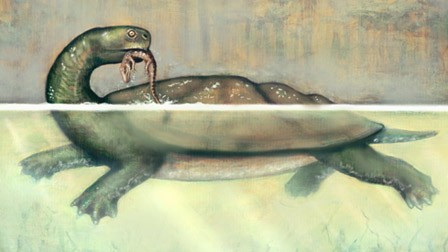Gigantic Turtle Fossils Found In Colombia

Paleontologists from North Carolina State University have discovered fossils of a huge turtle as big as a smart car.
Paleontologists who found the fossils in a coal mine in Colombia, claim that they are around 60 million years old.
"We had recovered smaller turtle specimens from the site. But after spending about four days working on uncovering the shell, I realised that this particular turtle was the biggest anyone had found in this area for this time period - and it gave us the first evidence of giantism in freshwater turtles," said Edwin Cadena, doctoral student at the North Carolina State University, in a statement
Paleontologists have named this turtle Carbonemys cofrinii, which means "coal turtle," and is part of a group of side-necked turtles known as pelomedusoides. The fossil was named Carbonemys because it was discovered in 2005 in a coal mine that was part of northern Colombia's Cerrejon formation.
The study claims that the size of the coal turtle skull is about 24 centimetres, roughly the size of a regulation NFL football. The shell which was recovered nearby and it is about 172 centimetres, or about 5 feet 7 inches, long.
Cadena said that this huge turtle had massive, powerful jaws that would have enabled the omnivore to eat anything nearby - from mollusks to smaller turtles or even crocodiles.
Paleontologists claim that smaller relatives of Carbonemys existed alongside dinosaurs. They claim that a giant version appeared five million years after the dinosaurs vanished, during a period when giant varieties of many different reptiles - including Titanoboa cerrejonensis, the largest snake ever discovered - lived in this part of South America.
Researchers believe that a combination of changes in the ecosystem - including fewer predators, a larger habitat area, plentiful food supply and climate changes - worked together to allow these giant species to survive. Carbonemys' habitat would have resembled a much warmer modern-day Orinoco or Amazon River delta.
Even though the turtle was huge and powerful, now only one specimen of this size has been recovered. They believe that this is because a turtle of this size would need a large territory in order to obtain enough food to survive.
"It's like having one big snapping turtle living in the middle of a lake," said Dr Dan Ksepka, paleontologists at the North Carolina State University. "That turtle survives because it has eaten all of the major competitors for resources. We found many bite-marked shells at this site that show crocodilians preyed on side-necked turtles. None would have bothered an adult Carbonemys, though - in fact smaller crocs would have been easy prey for this behemoth."
© Copyright IBTimes 2025. All rights reserved.



















